October 17th is observed as the International Day for the Eradication of Poverty every year across the globe. The day is aimed at raising awareness about the people living in poverty and suffering through the consequences of it. The day is also set to recognise all the efforts that are being made around the world at various levels for eradication of poverty. The theme of International Day for the Eradication of Poverty 2024 is “Ending Social and Institutional Maltreatment: Acting together for just, peaceful, and inclusive societies.”
What is Poverty?
According to Investopedia, poverty is the state or condition in which people or communities lack the financial resources and other essentials for a minimum standard of living. People and families who live in poverty may not have access to proper housing, clean water, healthy food, and medical attention. Poverty is a socioeconomic condition that is the result of multiple factors apart from income. These factors include race, sexual identity, sexual orientation, and access to education, among others.
India’s Progress in reducing Poverty
India has made a significant progress in reducing poverty. According to a recent report by Niti Aayog, about 248 million people have escaped multidimensional poverty in the last nine years. This is a significant reduction as the people that were multidimensionally poor represented 29 per cent of the total population in 2015-16, who now represent 11 per cent in 2023. Some of the major causes that are attributed to this progress are better access to education, nutrition, sanitation facilities, clean cooking fuel, housing, healthcare, etc. This has happened as the Government of India has made an effort to work on addressing each individual aspect of poverty, through various schemes such as Swachh Bharat Abhiyan, Pradhan Mantri Awas Yojana, Pradhan Mantri Ujjwala Yojana, Mid-Day Meal Scheme, Ayushman Bharat Yojana etc.; rather than focusing on just increasing the incomes of individuals.
The states that have realised most reduction in people living in poverty are Uttar Pradesh, Bihar, and Madhya Pradesh.
Monetary Poverty is still a major challenge
While the country has progressed in tackling poverty by addressing various dimensions of it, there is still a major gap when it comes to addressing the monetary poverty. According to the World Bank, about 11.9 per cent of the total population of India was living on less than $2.15 per day in the year 2021. This is the threshold for extreme poverty. The report by the World Bank also noted that there are major disparities between rural and urban areas and among various states. For example, the report has stated that the rural regions in the country have witnessed greater improvements, as compared to the urban areas, especially because of the increased migration to urban areas in the face of rising unemployment and not very significant rise in wages.
Conclusion
India has committed to reduce multidimensional poverty to less than 1 per cent by 2030. In order to meet this target, there is a need for continuous efforts by government, civil society, corporates and fellow citizens in a collaborative manner for coming up with inclusive and innovative solutions. It is only through a collaborative approach we can address the issue of poverty in a holistic manner and take complete advantage of the demographic dividend of India, thus getting closer to achieving the status of a “developed country”.


